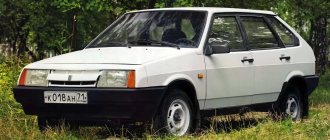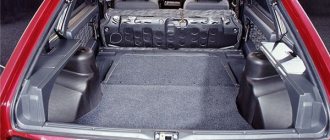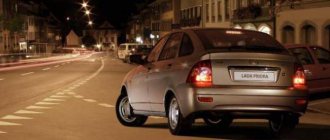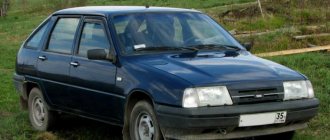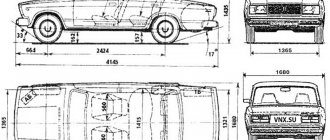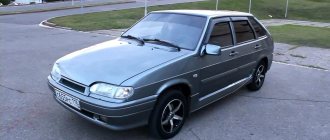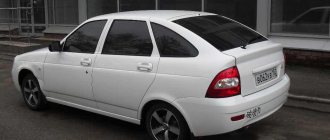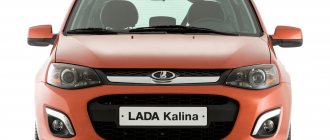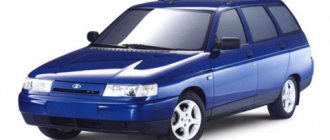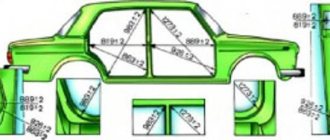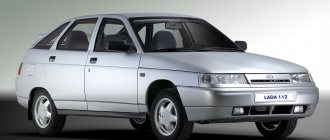Domestic cars are always popular among car owners. The main reason is availability in terms of price, as well as inexpensive maintenance. Back in Soviet times, VAZ earned a reputation as a high-quality and reliable car.
True, over time, drivers began to trust VAZ cars less, but this does not apply to older models like 2112 and those that came before it. The VAZ-2112 car began to be produced in the late 90s. And he still enjoys trust.
History of creation
The VAZ 2112 hatchback model was produced since 1999, becoming the successor to the 2110 sedan and 2111 station wagon. The “Twelfth” became a close analogue of the famous tenth model, but had a slightly shortened body. As planned by the manufacturers, the 2112 was supposed to combine all the advantages of the “ten” and “eleven”, so the five-door hatchback was chosen as the body type.
VAZ-2112 Pre-production (1994)
The 12th model began to be mass produced in 2000; it lasted 8 years on the assembly line. Unlike the sedan and station wagon of the tenth series, the assembly of the “dvenashka” was not transferred to the Ukrainian ones.
Although the twelfth model was positioned as an improved “ten”, the improvements here are very conditional and not always obvious. Therefore, the difference between these two models is not too big. AvtoVAZ designers continued to look for new solutions, as a result of which other lines and modifications appeared, which also have both their pros and cons.
Development of the model range
AvtoVAZ designers began to think about developing a sedan based on the VAZ 2108, 2109 series in the mid-80s. It was the development of this that led to the design split in Tolyatti, the consequences of which are still felt today. Instead of simply changing the contours of the rear part of the VAZ 2109 body and making a spacious trunk, the designers proposed almost a thousand different changes, including quite expensive ones. An electronic engine control and diagnostic system (on-board computer), a new galvanizing technology, power steering, etc. were provided. AvtoVAZ management, instead of closing the expensive project, decided to carry out work in two directions:
- complicated development of VAZ 2110;
- creation of a simplified version of the VAZ 21099.
Subsequently, both concepts coexisted in the design bureau and on the factory assembly line. The VAZ 2110 line developed into the 110 family and later into the Lada Priora, and the VAZ 21099 line became the basis of the Samara 2, Kalina and Kalina 2 family.
This development of the line has led to the fact that the plant’s assembly line currently produces series of cars with very similar technical characteristics, with weakly expressed sectoral market preferences.
Generations 2112
1995
2112
2000
21120
2000
21122
2004
21121
2004
21124
Exterior
Looking at the “twelve”, it immediately becomes clear that its prototype was the “ten”. Externally, these two cars are very similar, it is immediately clear that they belong to the same family: the same rounded, smooth lines and roundness of the body, the same heaviness, especially in the rear of the car. Of course, whether you like the design of the car is a matter of taste. Many note that the twelfth model is the most beautiful of the entire line.
Lada 2112 (1999–2008)
It is also noticeable that the designers tried to give the car some sportiness by adding a rather large spoiler to the trunk door, rounding the body as much as possible and replacing the thirteen-inch “tens” wheels with 14 inches. However, despite all the developers’ tricks, it’s quite difficult to call the 12th Lada sports. Changes also affected the roof of the car. Here it is more sloping, making the car look more interesting. The body length of the 2112 model is slightly shorter than that of the “ten”.
If we compare the car with the 11th model, then the rear door is noticeably larger, which can be opened both from the outside using the key and from inside the cabin by pressing the corresponding button. But the fifth door opens only if you pull it on the plastic spoiler, which does not have a positive effect on it.
Lada 2112 (1999–2008)
The trunk, like the hood, boasts gas struts. It is convenient to load, the volume is 400 liters. The shelf in the trunk rattles and knocks a lot when driving. You can get into the car through the trunk door if all other doors are blocked or jammed.
Bodies and what they are like
As you know, the body on the “ten” is load-bearing and repeats the basic design of any modern passenger car. Today it is customary to talk about several types of bodywork. The frame and supporting body are considered the main ones.
The difference between frame and load-bearing
How much does the body of a VAZ 2110 weigh?
All the main components of the car are located on the frame; it serves as a support and is itself fixed to the wheels of the car by means of suspensions. If you pay attention to trucks, then the frame can be seen with the naked eye, and thus you can draw appropriate conclusions about its structure. In “passenger cars” there is no frame, or it would be more accurate to say that on some passenger cars the frame-body assortment forms a single whole, called the body.
Frameless bodies, which include the metal frame of the VAZ 2110, are made in such a way as to withstand the mass of numerous heavy components. For this purpose, the body floor is well reinforced, and most of the overall parts are made of materials with a lightweight base.
On frameless bodies, the role of the frame is performed by the spars. They can be said to be responsible for the massiveness of the entire body structure. From time to time, these components are subjected to unplanned and shock loads that change very quickly in different directions. This operating scenario cannot have a positive effect, and over time, the welding points break, the bolts become loose, and the solidity of the entire body structure weakens.
VAZ 2110 body diagram
The car body also feels the load from a running engine. It vibrates strongly, although the engine itself and the cylinders are designed to absorb some of the vibrations. To minimize the effects of vibrations on the body, manufacturers use special cushions or dampers, as well as washers made of dense rubber.
Note. The effect of these pads can be clearly determined by monitoring the operating unit with the hood open. The engine “growls” and shakes, but the body doesn’t care.
The most important task of a frameless car body is to transport luggage and passengers. At the same time, the machine must also provide major protection. The number of people transported and the weight of the permissible load are determined by the designers responsible for the layout and other parameters of the body.
If you imagine the frame of a “car” in the form of its components, then its main parts are three main zones, implying the trunk, the passenger compartment and the front. The finished look of the solidity of the frame is given by its hinged parts or “plumage”, which includes various panels.
Body types of the “tenth” family
VAZ 2110 body diagram
The difference in body types, again, is associated with what one or another model is intended for. The car may be intended for off-road travel, and then it will be designed as a crossover or a full-fledged all-terrain vehicle, or it may be intended only for city driving.
Note. The body of the VAZ 2110 is a typical sedan. Models associated with the “ten” already have other body types: 2111 – station wagon, 2112 – 5-door hatchback, 21123 – coupe or 3-door hatchback.
It will be useful to know that over the entire production period of the 2110 model, VAZ creates many variations of this sedan. In particular, the Consul limousine, with an even longer wheelbase, deserves attention.
The design of the sedan began immediately after the VAZ 2108 became obsolete, when the plant decided to replace the project. But the release of the “ten” was not yet imminent. The fact is that the designers made many revolutionary improvements that significantly increased the cost of the project. Due to the economic crisis that reigned in the country at that time, the project was moved forward several years, and only in 1995 mass production of the “ten” began.
VAZ 2110 body diagram of station wagon 2111
The sedan is the classic and most popular body style of modern cars. The interior includes 2 rows of seats and usually accommodates 4-5 people including the driver. The luggage compartment in sedans is properly separated from the interior.
For many, to this day, the question of the merits of the VAZ 2110 car is somewhat controversial. It is clear that it cannot compare with foreign cars, but the presence of “ten” running on the roads of our country speaks volumes.
Dimensions and how much it weighs
The body length of the “ten” sedan is 4265 mm, which is only slightly less than the “universal” dimensions. This length looks the most organic not only among the models of the “tenth” family, but also in VAZ as a whole.
Instructions for VAZ 2110 body dimensions and repairs
We also note that the length of the “ten” is 6 cm longer than the length of the only “Samarov” sedan - VAZ 21099. The same goes for other parameters:
- The longitudinal distance between the wheel axles is 3.2 s longer;
- Body height is 1.8 cm higher;
- Ground clearance is 5 cm higher.
But both gauges are the same for “99” and “tens”. In addition, both models have similar gearboxes and engines. But still, in general, the technical characteristics of the “tens” and “99” are different. The “Ten” is able to achieve better speed and demonstrate enviable maneuverability on the road compared to the “99”, precisely due to the body design, made with modernizations and significant improvements. In particular, these are smooth body lines and completely modernized control systems.
Due to the greater length, which experts called “ideally sufficient,” the trunk of the VAZ 2110 sedan becomes very spacious. Its usual layout is 415 liters, which is already the envy of competitors.
Dimensions 2110
The large volume of the luggage compartment allows you to transport by car not only the essentials, including a spare wheel and tools, but also many additional things. If you remove the rear seats, turning the rear of the cabin into an additional trunk, you can transport up to 1270 liters of cargo.
The wheelbase of the “ten” is 2492 mm, which is also very good. If we add to this the length of the trunk - 944 mm, then on a long journey, if you have a sleeping mattress, you can make a quite comfortable bed.
VAZ's new sedan is wider, taller and longer, but also heavier than the standard family of cars (1020 kg). This was to be expected, because the designers sought to increase the interior space, thereby increasing the comfort of people sitting in the cabin.
Interior
The interior of the car is simple and not very presentable. You won’t find any “bourgeois excesses” here. The only exception is electric windows and heated front seats, but this is not found in all modifications of the car.
The steering wheel is large and very antediluvian. The steering column is height adjustable only. Moreover, some models come without power steering and electric power steering, which is a significant disadvantage.
Torpedo Lada 2112 (2006-08)
To the right of the steering wheel is a console with a heater, radio, on-board computer (if equipped) and main keys. The heater, in theory, should be adjustable in order to separately heat the windows, top and bottom of the cabin, but in reality everything is heated at once. There are no airbags in the cabin.
The glove compartment is quite large and even has a backlight. The position of the exterior mirrors is adjusted by a special lever, but it is adjusted very mediocrely, so usually no one uses it.
A tall person is unlikely to be comfortable in the back row of seats, because his head will touch the ceiling. Long-legged people will also not be very comfortable, since there is quite a bit of space left to the front seats. The width of the cabin is cramped; only two passengers can be comfortably accommodated. Three people will fit, but they will be cramped.
Interior of Lada 2112 (1999–2008)
The rear windows are manual and constantly stick. As anyone who has ever owned a Lada, Zhiguli or any other AvtoVAZ product knows, the windows go down exactly to the level they want. Often it is completely impossible to lower the glass completely; it gets stuck in the middle and does not move anymore.
The rear row seats recline together or separately, which increases the size of the trunk, so you can put a fairly large load in the car.
Tuning
VAZ-2112 is one of the best solutions of the Russian automobile industry. The car has little comfort. However, many people strive to highlight their vehicle through tuning. Nowadays, tuning has become very popular, especially for domestic cars. Due to the fact that manufacturers have reduced the body size, the hatchback has become more comfortable to drive.
Another advantage can be added to the high ability to maneuver during turns, which makes this car look like a sports class car. “Dvenashka” is, on the whole, a complete and comfortable car, but almost every master will find something that needs to be improved. For example, you can update the silhouette of a car. For this, various additions are used that allow you to create a new appearance for the Lada 2112. In addition, experts advise increasing the aerodynamic data of the vehicle.
Appearance tuning
To change the appearance, new body components should be used. Some VAZ-2112 owners resort to a stylish aerodynamic body kit, which can have a different appearance. There is a sporty type, and there is a body kit that emphasizes the unique style and characteristic feature of the Soviet hatchback.
After installing such body kits, the “two-piece” will be a little similar to American cars. There are two types of aerodynamic body kit for such a five-door:
- The first - with a sporty bias - affects the smoothness of control when moving at high speed due to the correct structure;
- The second is one that improves style. The kit includes an impressive air intake, which allows you to easily cool the power unit and braking system.
You can upgrade your car if you work on its lighting. The lighting is installed not only under the bottom itself, but also the lights located at the stern. More modern front optics will help rejuvenate the hatchback, giving it a sporty touch. In this case, LED lighting is used.
On the practical side, you can install a heated windshield, which helps save a lot of time when cleaning the glass in winter. In the warm season, such tuning of the VAZ-2112 helps reduce fogging of the vehicle.
Interior tuning
The interior of the car is the favorite part of the car for tuning enthusiasts. Typically, owners decide to install lighting in the interior. Not everyone likes the standard dashboard lighting. Such work can be carried out by any car owner of a Lada 2112 hatchback. There are craftsmen who replace the ceiling with one similar to that of a Lada Priora.
It fits perfectly as it matches the dimensions. Similar actions are carried out with door trim. To improve the level of comfort, noise insulation work is being carried out. Also, for convenience, new seats with good lateral support, a high-quality music system, etc. are installed.
Tuning the technical part
To modernize the technical characteristics of the twelfth model, it is important to increase the displacement. It is determined based on the stroke diameter and piston. To increase this volume, use a factory version or do-it-yourself improvement. If you choose the second case, you will have to convert the factory stroke, but in this way it will not be possible to significantly increase the volume.
Engine chip tuning is very popular today. There is an economical and original sports version of chip tuning for the VAZ 2112. The sports method includes increasing the dynamic performance of the car in the city. You will have to be prepared for increased fuel consumption.
If your large fuel appetite is a bit daunting, you can switch to gas equipment. The economy option reduces fuel consumption in the city, which is what many people are interested in.
These works are carried out using special equipment and skills, so it is strongly recommended to carry out such processes at high-quality service stations.
Engine modifications
Under the hood of Lada 2112 (1999–2008)
In total, there are 6 engine modifications for the VAZ 2112:
- 21120 – the basic version of the 1.5 liter internal combustion engine. The disadvantage is the presence of free space inside the cylinder head and the block itself.
- 21124 – increased power (up to 89 hp) and increased engine capacity (up to 1.6 liters).
- 21126 – power increased to 98 hp. with an engine capacity of 1.6 liters.
- 21127 – the volume is still 1.6 liters, but the power is increased to 106 hp.
- 21128 – power is 105 horses, which is achieved by increasing the volume of the combustion chamber (1.8 liters). The problem with the valves bending has been resolved.
- 21129 – the engine has a volume of 1.8 liters, a phase shifter has been added.
What is firmware
This is a special program that contains a certain set of corrections and calibrations, which allows you to control the engine in automatic mode. It also uses a set of readings from different sensors:
- mass air flow;
- crankshaft position;
- detonation;
- throttle position.
Based on these sensors, the firmware can produce hundreds of calibration options. All this is necessary for the coordinated and elastic operation of the engine at different speeds. The firmware is “flooded” in the engine. It is the ECU that determines how much fuel mixture and what ratio needs to be supplied to a particular cylinder in a given period of time.
Chip tuning is a software change in the VAZ firmware by replacing some settings with more “advanced” ones. It is worth noting that such firmware can be built for different tasks. So, one program is designed for fuel economy, the other for high power and torque.
Options
Lada 112 Coupe (2002–06)
The car was produced in several versions:
- 21120 – basic version with a 16-valve 1.5-liter engine with multipoint injection. Equipped with 14-inch wheels. Engine power – 93 hp.
- 2112i – version with fuel injection system.
- 21120 GLI (Gran Luxury Injector) – luxury version of the car.
- 21121 – modification with an engine capacity of 1.6 liters. Power – 81 hp
- 21122 – simplified, budget option. It was produced without electric windows, with 13-inch wheels and brakes from the VAZ 2108.
- 21123 Coupe - a three-door version, the so-called “coupe”, although in fact it is an ordinary three-door hatchback. It was assembled individually and in limited edition. The coupe's body is more rigid, as is the suspension. Handling is better than the standard version. The car was expensive, produced in 2002-2006.
- 21124 – injection version with a 1.6-liter engine. By increasing the depth of the groove in the piston crown, the creators managed to solve the problem of valve bending, which plagues the standard version.
- 21128 – modification with a 1.8-liter engine. Power – 105 hp.
- 2112-37 – racing version with a 1.5 liter engine, equipped with a roll cage.
- 2112-90 “Tarzan” – version with all-wheel drive. A Niva engine (1.7 and 1.8 liters) was installed.
Pros and cons of the twelfth model
The duality of the design concept led to the fact that the Lada 12 was never the only five-door hatchback in the production program of the Tolyatti plant. The AvtoVAZ hatchback VAZ 2112 rolled off the assembly line from 1999 to 2008. It shared its place on the assembly line with other five-door cars in the same body:
- from 1999 to 2001, Lada 12 and VAZ 2109 were produced in parallel;
- from 2001 to 2004, VAZ 2112, VAZ 2109 and VAZ 2114 were released simultaneously;
- from 2004 to 2008, model 12 was produced in parallel with the VAZ 2114.
The features of the target audience of the 12th fret are very poorly read, in contrast to alternative models. Buyers of the VAZ 2109 represented a large army of staunch supporters of the most popular domestic car of the 90s - the “nine”, glorified in songs. The fourteenth model that appeared later also had many fans. A light face lift only benefited the car. New headlights and the design of the front end refreshed the appearance of the car; it became noticeably more modern, which the market liked.
The Lada 12 had little to offer in this competitive competition. The electronic fuel injection engine control system offered few advantages because the first twelfth models entered the market with a carburetor version of the engine. When injection versions of the Lada 12 appeared, competitors were not slow to repeat this move. All that remained was a more than dubious attempt to follow the ideas of biodesign that was fashionable at that time. Such tuning of the VAZ 112 did not give serious success, because:
- the ideas themselves were 15 years out of date by the time the car appeared;
- they were implemented very clumsily.
In terms of technical parameters, models 2112 and 2114 are very similar. VAZ 2112 is 4 centimeters longer than its brother in the production line. For comparing cars of the same layout, the volume of a cube is great, into which you can fit a car with specific dimensions. This parameter is in the case of model 2114 4122 mm x 1650 mm x 1402 mm = 3817 cubic meters. dm. And for 2112 - 4170 mm x 1680 mm x 1435 mm = 4050 cubic meters. dm. The difference is 5.7%. In terms of total weight, the cars (1410 and 1495 kg, respectively) differ by 5.6%.
But the trunk of the VAZ 2114 is significantly smaller - 330 liters versus 399. Additionally, in Lada 12 you can free up another 330 liters for luggage by folding the rear seats. You can fold them partially - the back is divided in a ratio of 1:2, and the parts fold independently of each other. Car owners note that the interior of the twelfth model is cramped for passengers taller than 180 cm. Common to both cars, car enthusiasts note shortcomings in the operation of the heating system, shortcomings in seat adjustments, as well as a creaky interior.
The direct descendants of the 2112 and 2114 models, the Lada Priora and Lada Kalina 2 hatchbacks, differ little from each other and are sold in the same market sectors as their predecessors.
Chassis and its advantages
On the move, the “two-piece” is akin to a foreign car of those times: soft, smoothly overcoming bumps. The whole feeling is spoiled by the front panel bouncing on the pits.
The clearance of the VAZ-2112 is high even by today's standards. 160 cm along with short overhangs allow you to easily climb curbs and easily drive through large holes without touching the bottom. When fully loaded, due to the design, the rear wheels begin to “shuffle” against the arches.
Disadvantages of VAZ-2112
Most used Twelves are sold with corrosion. It covers the rear fenders, the spare wheel well, the sills, the bottom, and the contour of the windshield rubber seal. If the car has not been looked after, there may be corrosion at the bottom of the doors.
Replacement will cost a decent amount: doors excluding painting - about 9,000 rubles apiece, rear fenders - about 6,000 rubles, a niche for a spare wheel - 1,500 rubles. For painting one element you will have to pay at least 5,000 rubles per element. Even at the slightest hint of rust, run away from the car. It’s better to take a closer look at the well-painted version: it has no corrosion - you won’t have to spend money on repairs.
When buying a 16-valve engine, set aside 6,000 rubles to replace hydraulic compensators (they last no more than 100 thousand km, and if the oil quality is poor, even less), on many cars they knock. The mass air flow sensor often fails. The first signs by which you will know about a breakdown will be increased fuel consumption and high idle speed (replacement - from three thousand rubles).
Also pay attention to the front struts and their supports. The former often fail after 30 thousand kilometers, while the latter’s tires begin to peel off (all together will cost from 6,000 rubles).
Another common problem with the VAZ-2112 is non-working rear lights. You will have to either change the board or clean and tighten the contacts. By the way, the rear lights of the “twelve” often fog up, and this, unfortunately, cannot be cured.
Specifications
Visibility
Visibility in the cabin is good, everything is perfectly visible from the driver's seat, the glass area is large. However, the rear view is partially blocked by the spoiler.
Body
The bodies of all Lada cars leave much to be desired. They are made of thin and very low quality metal that rusts instantly. The sills, arches and lower parts of doors are most susceptible to corrosion. If you find a VAZ 2112 in good condition, then both the arches and the sills will probably be overcooked.
Mileage
If you monitor the car and the condition of the engine, then the VAZ 2112 can “run” up to 200-250 thousand, which is not too much. On the other hand, the engine can be rebuilt or a new one installed, because Lada engines are obscenely cheap.
Lada 2112 (1999–2008)
The fuel consumption of the “twelfth” cannot but rejoice. So in urban conditions it consumes 7-9 liters per 100 km. On the highway - 5-6 liters.
Transmission
The 12th model was equipped with a 5-speed manual transmission. It differs from the gearbox on the VAZ 2110 only in name.
Disadvantages of a gearbox on a “two-wheeler”:
- unreliability;
- unclear switching;
- strong howl;
- frequent wear of the synchronizer, accompanied by crackling and noise when changing gears;
- oil leaks through seals, breather and gaskets;
- knockout of the gear or refusal to engage due to wear of the bushings;
- failure of bearings and gears after 100 thousand mileage.
Suspension
The front suspension of the VAZ 2112 is independent, the rear suspension is dependent. The problem with all LADA cars is CV joints and bearings that quickly fail. The struts also quickly begin to leak, the springs rust. The quality of spare parts generally leaves much to be desired, including new ones. Owners complain that some elements have to be replaced several times, because new parts arrive already defective or break in the first months of operation.
Tens body care and repairs
Do-it-yourself VAZ 2110 body repair
The overall body of the “ten” looks more reliable, durable and resistant to corrosion. All-metal and partially galvanized, it comes off the assembly line already treated with anticorrosive, ready for harsh operating conditions.
On the other hand, we must pay tribute to our car owners, who are accustomed to finishing everything with their own hands. In particular, while remaining adherents of the domestic automobile industry, they turn a blind eye to the differences and shortcomings of technology in comparative terms and take additional care of the body so that it serves for many years without problems. Russian car owners almost always add special protection to the standard anti-corrosion treatment.
VAZ 2110 body repair and polishing
Preventative work specifically involves tinting the bottom of the car, treating sills and fender liners with Movil.
Note. We can say with confidence that among the “dozens” with high mileage, even today you can find examples that have been so well cared for by the owner that they look like new.
People's love for the “ten” is also symbolized by the succinct names given to the car by amateurs. “Matryoshka”, “pregnant antelope”, “chubby” - all these nicknames, albeit with some degree of irony, speak of love for the car. If at first the unique, new design of the VAZ model raised questions, then over time the angular shapes of the “bow” and “stern” became familiar.
Here are the preventive works that are usually carried out on the body of the “tens” throughout the entire operational period:
- Caring for paintwork;
- Lubrication of metal components of the body;
- Cleaning of technical holes;
- Periodic anti-corrosion protection of the body as a whole and treatment of hidden areas;
- Noise insulation;
- Sealing.
VAZ 2110 body repair
To protect the original paintwork of the body, you must be able to select the appropriate polishes and follow the rules for their application. In addition, the VAZ 2110 must first be washed when the car is new, only with cold water, and for treating paintwork, use polishes that do not contain abrasives.
Caring for the paintwork of a car with a 3-5 year mileage implies a different scenario:
- Use products for weathered surfaces (they contain a certain amount of abrasive).
Accordingly, for a body older than 5 years:
- Use products specifically designed for aged surfaces.
It is also recommended to polish the body in small areas by hand using clean flannel. This is done to prevent the polish from drying out during application.
Polishes PMA-1 and PMA-2 have proven themselves well.
Body polish
More good tips on the body in general:
- Do not store the car under rubber covers;
- Do not place rubber objects on painted surfaces (they will leave stains that are almost impossible to remove);
- Protect the paintwork from contact with alkalis, brake fluid and other chemicals that can destroy the coating.
It is recommended to lubricate rubbing parts and body elements from time to time in order to increase the durability of the metal frame. So, this should be done at least every 15 thousand km of the car or once a year.
Here's how and where to do it:
- Apply engine oil to door hinges;
- Apply CV joint grease-4 or Molikot to the limiters;
- Lubricate door locks with FIOL-1;
- Apply VTV-1 aerosol lubricant to the lock cylinders;
- Use the same product to lubricate the hinges and springs of the fuel tank hatch;
- Lubricate the hood lock with FIOL-1;
- Use the same tool to lock the trunk lid.
Anticorrosive treatment also needs to be given great attention. Hollow parts of the body and parts located in the lower part are most susceptible to the negative effects of rye (they are constantly exposed to moisture and dirt due to their close location to the road surface).
It has proven itself well for protecting the metal components of the body from corrosion. As for the treatment period, it is recommended to carry it out every year.
Due to the complexity of the work, it is recommended to treat hidden body cavities with anticorrosive agents at a service station. If the garage has the appropriate tools and equipment, then the process is as follows:
- The car is placed on a jack;
- The casing and all components that interfere with access to hidden cavities are removed;
- The holes are washed until clean water flows out;
- The surfaces are thoroughly dried, and all areas where the anticorrosive is applied are blown with compressed air.
The table below shows hidden cavities and how to apply anticorrosive.
Brake system
Front brakes are disc, rear brakes are drum. Although the brakes on the “two-wheeler” are quite mediocre and ineffective, owners most often do not complain about them, because repairs cost a small amount. The brake pedal is usually a little stiff, but the braking distance is acceptable.
Lada 2112 (1999–2008)
We will enter the remaining technical characteristics into the table.
| Parameter | Index |
| Body shape | hatchback (5 doors), coupe (3 doors) |
| Engine volume, l | 1.5, 1.6, 1.8 |
| Length, mm | 4170 |
| Width, mm | 1680 |
| Height, mm | 1420 |
| Wheelbase, mm | 2492 |
| Ground clearance, mm | 160 |
| type of drive | front |
| Gearbox type | 5-speed manual |
| Weight, kg | 1495 |
| Trunk volume, l | 400 |
| Fuel tank volume, l | 43 |
| Fuel type | petrol |
Results
Although the VAZ-2112 car has not been produced for a long time, it can be seen quite often on the streets of many cities in the post-Soviet space. The car was able to prove itself well, especially at the beginning of production. Many even mistook this hatchback for a foreign car. Even today, the car does not have such a rough design as, for example, the “nine” or similar cars, and even looks modern.
If the driver does not leave his car unattended, it will look good. “Dvenashka” received an average ground clearance, front-wheel drive, a more or less good interior and a spacious trunk. It is clear that the model cannot compete with foreign cars, but for its price it is the best option.
It is especially suitable for tuning lovers, as it has a lot of opportunities for improving the appearance, interior and technical parts. It will not be possible to avoid a poor-quality interior and low level of noise insulation. Also inside, especially in the back row, there is not enough free space. Creaking sounds will constantly accompany the driver on the road.
The power of the power plants is not always enough; the lack of power is mainly felt when overtaking. But the engine can be called quite economical, even in urban areas. The VAZ 2112, although not an ideal car, is good for a first car, as it has a low cost on the secondary market, low price tags for spare parts and is easy to repair.
We advise you to read the article: History of AvtoVAZ - LADA cars
Controllability
It would seem that the reduced base (when compared with the “ten”) should have made the car more obedient, but for some reason everything is different with the “two”. Handling here is very mediocre. When turning, you often have to fight with the steering wheel, which constantly strives to return to its original position. There are cars without power steering, the driving of which gives little pleasure, and the steering wheel seems to be filled with lead and generally refuses to rotate adequately.
Lada 2112 (1999–2008)
When cornering, the body often begins to sway and roll to the side, causing the wheels to lose traction on the asphalt. This happens especially often on rough roads. It is better not to accelerate too much in the VAZ 2112, because at high speeds you can easily lose control.
Opinion of car enthusiasts
Owner reviews of the VAZ 2112 are mostly positive. Despite many shortcomings, poor build quality and components, this car is highly popular among the younger generation in Russia and some CIS countries.
The reasons for such a loyal attitude towards the car can be considered its attractive body design, as well as high-torque engines.
VAZ 2112 dimensions and weight
Overall dimensions of Lada 2112 are from 4170 x 1680 x 1435 to 4193 x 1680 x 1435 mm, and weight is from 1030 to 1060 kg.
Dimensions Lada 2112 2002, hatchback 3 doors, 1st generation
03.2002 — 11.2009
| Options | Dimensions | Weight, kg |
| 1.6 MT Basic 3-door 21123 | 4193 x 1680 x 1435 | 1030 |
| 1.8i MT Base 3-door | 4193 x 1680 x 1435 | 1060 |
Dimensions Lada 2112 1999, hatchback 5 doors, 1st generation
02.1999 — 07.2008
| 1.5 MT Basic 5-door 2112 | 4170 x 1680 x 1435 | 1040 |
| 1.5 MT Basic 5-door 21122 | 4170 x 1680 x 1435 | 1040 |
| 1.5 MT Basic 5-door | 4170 x 1680 x 1435 | 1040 |
| 1.6 MT Basic 5-door | 4170 x 1680 x 1435 | 1040 |
| 1.6 MT Basic 5-door 21124 | 4170 x 1680 x 1435 | 1040 |
| 1.8 MT Lux 5-door | 4170 x 1680 x 1435 | 1040 |
Weight of passenger cars in tabular format
We present to your attention a table that shows the weight of the car by brand.
| car model | Curb weight |
| Weight of the Oka 1111 car, weight of the Okushka | 635 kg |
| Weight of the car Oka 1113 | 645 kg |
| Weight of a VAZ 2101 car, weight of a penny | 955 kg |
| Weight of the VAZ 2102 car | 1010 kg |
| Weight of the VAZ 2103 car | 965 kg |
| Weight of the car VAZ 2104, weight of tens 2110 | 1020 kg |
| The weight of the VAZ 2105 car, the weight of the five | 1060 kg |
| Weight of the VAZ 2106 car, weight of the six | 1045 kg |
| Weight of the VAZ 2107 car, weight of the seven | 1049 kg |
| Weight of the VAZ 2108 car | 945 kg |
| Weight of the VAZ 2109 car, weight of the nine | 915 kg |
| Weight of the VAZ 2111 car | 1055 kg |
| Weight of a VAZ 2112 car, weight of a twelve-wheeler | 1040 kg |
| Weight of the VAZ 2113 car | 975 kg |
| Weight of the VAZ 2114 car, weight of the four | 985 kg |
| Weight of the VAZ 2115 car, weight of the tag | 1000 kg |
| Weight of the VAZ 2116 car | 1276 kg |
| Weight of the VAZ 2117 car | 1080 kg |
| Weight of the Niva 2121 car | 1150 kg |
| How much does a Chevrolet Cruze weigh (Chevrolet Cruze weight) | 1285-1315 kg |
| How much does a Chevrolet Niva weigh (Chevrolet Niva weight) | 1410 kg |
| How much does a GAZ (Volga) weigh, the weight of a Volga 24 | 1420 kg |
| How much does GAZ 2402, GAZ 2403, GAZ 2404 weigh? | 1550 kg |
| How much does GAZ 2407 weigh? | 1560 kg |
| Car weight Moskvich 314 | 1045 kg |
| Weight Moskvich 2140 | 1080 kg |
| Weight Moskvich 2141 | 1055 kg |
| Car weight Moskvich 2335, 407, 408 | 990 kg |
| How much does a UAZ 3962, UAZ 452 weigh, how much does a UAZ loaf weigh? | 1825 kg |
| How much does UAZ 469 weigh? | 1650 kg |
| How much does UAZ Patriot weigh? | 2070 kg |
| How much does UAZ Hunter weigh? | 1815 kg |
| How much does Nissan weigh (weight of nissan x-trail car) | 1410-1690 kg |
| How much does Qashqai weigh (weight of Nissan Qashqai car) | 1297-1568 kg |
| How much does Nissan Juke weigh (Nissan Beetle weight) | 1162 kg |
| Ford Focus car weight (how much does a Ford Focus weigh) | 965-1007 kg |
| Weight of the Ford Focus 2 car (how much does the Ford Focus 2 weigh) | 1345 kg |
| Weight of the Ford Focus 3 car (how much does the Ford Focus 3 weigh) | 1461-1484 kg |
| Ford Kuga car weight (how much does a Ford Kuga weigh) | 1608-1655 kg |
| Ford Escort car weight (how much does a Ford Escort weigh) | 890-965 kg |
| Weight of the Renault Logan car (how much does the Renault Logan weigh) | 957-1165 kg |
| Renault Duster car weight (how much does a Renault Duster weigh) | 1340-1450 kg |
| Renault Sandero car weight (how much does a Renault Sandero weigh) | 941 kg |
| Weight of the Opel Mokka car (how much does the Opel Mokka weigh) | 1329-1484 kg |
| Weight of the Opel Astra car (how much does the Opel Astra weigh) | 950-1105 kg |
| Mazda 3 car weight (how much does Mazda 3 weigh) | 1245-1306 kg |
| Weight of the Mazda CX-5 (how much does the Mazda CX-5 weigh) | 2035 kg |
| Mazda 6 car weight (how much does Mazda 6 weigh) | 1245-1565 kg |
| Volkswagen car weight (how much does a Volkswagen Tuareg weigh) | 2165-2577 kg |
| Weight of a Volkswagen Polo car (how much does a Volkswagen Polo weigh) | 1173 kg |
| Weight of the Volkswagen Passat car (how much does the Volkswagen Passat weigh) | 1260-1747 kg |
| How much does a Toyota Camry weigh (Toyota Camry weight) | 1312-1610 kg |
| How much does Toyota Corolla weigh (weight of Toyota Corolla) | 1215-1435 kg |
| How much does a Toyota Celica weigh (Toyota Celica weight) | 1000-1468 kg |
| How much does a Toyota Land Cruiser weigh (Land Cruiser weight) | 1896-2715 kg |
| How much does the Skoda Octavia weigh (Skoda Octavia weight) | 1210-1430 kg |
| How much does the Skoda Fabia weigh (Skoda Fabia weight) | 1015-1220 kg |
| How much does the Skoda Yeti weigh (Skoda Yeti weight) | 1505-1520 kg |
| How much does a Kia Sportage weigh (KIA Sportage weight) | 1418-1670 kg |
| How much does Kia Sid weigh (KIA Ceed weight) | 1163-1385 kg |
| How much does the Kia Picanto weigh (KIA Picanto weight) | 829-984 kg |
Thus, it turns out that if we take, so to speak, “in general for the hospital,” then the average weight of a passenger car is approximately from 1 to 1.5 tons, and if we talk about SUVs, then the whole weight already shifts from 1.7 tons to 2. 5 tons.
weight of a passenger car, how much does OKA weigh, how much does a car weigh, weight of a car, how much does a Matiz weigh, how much does a Matiz weigh, weight of a Skoda car, weight of an Audi
How many seats in VAZ 2112
The Lada 2112 car has 5 seats.
How many seats in Lada 2112 2002, hatchback 3 doors, 1st generation
03.2002 — 11.2009
| Options | Number of seats |
| 1.6 MT Basic 3-door 21123 | 5 |
| 1.8i MT Base 3-door | 5 |
How many seats in Lada 2112 1999, hatchback 5 doors, 1st generation
02.1999 — 07.2008
| 1.5 MT Basic 5-door 2112 | 5 |
| 1.5 MT Basic 5-door 21122 | 5 |
| 1.5 MT Basic 5-door | 5 |
| 1.6 MT Basic 5-door | 5 |
| 1.6 MT Basic 5-door 21124 | 5 |
| 1.8 MT Lux 5-door | 5 |
Selling a car for scrap metal. Admission rules
The Metla company has been accepting scrap metal and removing old cars for several years. Concluding a deal with a company and receiving funds will not be tiresome for you. Thanks to round-the-clock acceptance of applications, you can agree with the operator at any time to hand over an unwanted car.
To leave a request, call the number listed on the website.
At the time of execution of the contract you must have:
- technical equipment passport;
- personal passport;
- traffic police permit for car disposal
If you cannot deliver the car yourself to the collection point, then the Metla company has all the necessary equipment for its delivery:
Trunk volume of VAZ 2112
The trunk on the Lada 2112 is 350 liters, depending on the configuration.
Trunk volume Lada 2112 2002, hatchback 3 doors, 1st generation
03.2002 — 11.2009
| Options | Trunk capacity, l |
| 1.6 MT Basic 3-door 21123 | 350 |
| 1.8i MT Base 3-door | 350 |
Trunk volume Lada 2112 1999, hatchback 5 doors, 1st generation
02.1999 — 07.2008
| 1.5 MT Basic 5-door 2112 | 350 |
| 1.5 MT Basic 5-door 21122 | 350 |
| 1.5 MT Basic 5-door | 350 |
| 1.6 MT Basic 5-door | 350 |
| 1.6 MT Basic 5-door 21124 | 350 |
| 1.8 MT Lux 5-door | 350 |
Features of car recycling
Before you scrap your car, you should familiarize yourself with the principles of this procedure. The average weight of a vehicle is 1000 kg. If the entire car can be recycled, the collection point will deduct 30% for clogging. The latter includes all non-metallic elements, pollution, etc.
Let's consider how much a car for scrap metal weighs using the example of a VAZ 2105. The weight of the latter is 955 kg. Thus, taking away the blockage, we get about 660 kg. You should also take into account the price of scrap, which differs depending on the city. As a rule, in megacities, the number of rubles received for a car will significantly exceed the amount earned in a similar organization in a small locality.
Before calculating the profit from a scrapped car, you need to take into account transportation costs. If the car is a pile of metal, you need to take care of a tow truck. If there are spinning wheels and functional steering, the car can be transported in tow. Then, this expense item will not be so significant. Therefore, in order to calculate how much a Zhiguli costs when scrapped, it is not enough to know how much a VAZ 2109 or 21099 weighs for scrap metal (915 kg). It is necessary to take into account the features of recycling and the requirements of collection points. It would be useful to know the average cost of scrap metal in the region. Additional awareness will allow you to avoid fraud on the part of unscrupulous receivers.
Despite the fact that disassembling a car is a labor-intensive procedure, many owners still decide to take this step. Thus, you can sort ferrous and non-ferrous metals and hand them over separately, removing the good parts. From an economic point of view, the procedure will be justified.
Let's consider how much a VAZ 2106 weighs for scrap metal based on individual significant structural elements:
It should be noted that dismantling machine parts requires a lot of time and certain skills. In the absence of the latter, it would be more rational to recycle it entirely.
Source
What drive does the VAZ 2112 have?
Drive Lada 2112 2002, hatchback 3 doors, 1st generation
03.2002 — 11.2009
| Options | type of drive |
| 1.6 MT Basic 3-door 21123 | Front (FF) |
| 1.8i MT Base 3-door | Front (FF) |
Drive Lada 2112 1999, hatchback 5 doors, 1st generation
02.1999 — 07.2008
| 1.5 MT Basic 5-door 2112 | Front (FF) |
| 1.5 MT Basic 5-door 21122 | Front (FF) |
| 1.5 MT Basic 5-door | Front (FF) |
| 1.6 MT Basic 5-door | Front (FF) |
| 1.6 MT Basic 5-door 21124 | Front (FF) |
| 1.8 MT Lux 5-door | Front (FF) |
Ground clearance VAZ 2112
Ground clearance Lada 2112 2002, hatchback 3 doors, 1st generation
03.2002 — 11.2009
| Options | Ground clearance, mm |
| 1.6 MT Basic 3-door 21123 | 160 |
| 1.8i MT Base 3-door | 160 |
Ground clearance Lada 2112 1999, hatchback 5 doors, 1st generation
02.1999 — 07.2008
| 1.5 MT Basic 5-door 2112 | 160 |
| 1.5 MT Basic 5-door 21122 | 160 |
| 1.5 MT Basic 5-door | 160 |
| 1.6 MT Basic 5-door | 160 |
| 1.6 MT Basic 5-door 21124 | 160 |
| 1.8 MT Lux 5-door | 160 |
Transmission VAZ 2112
Lada 2112 is available with the following types of transmission: Manual transmission.
Transmission Lada 2112 2002, hatchback 3 doors, 1st generation
03.2002 — 11.2009
| Modifications | Transmission type |
| 1.6 l, 89 hp, gasoline, front-wheel drive | Manual transmission 5 |
| 1.8 l, 120 hp, gasoline, front-wheel drive | Manual transmission 5 |
| 1.8 l, 98 hp, gasoline, front-wheel drive | Manual transmission 5 |
Transmission Lada 2112 1999, hatchback 5 doors, 1st generation
02.1999 — 07.2008
| 1.5 l, 71 hp, gasoline, front-wheel drive | Manual transmission 5 |
| 1.5 l, 76 hp, gasoline, front-wheel drive | Manual transmission 5 |
| 1.5 l, 78 hp, gasoline, front-wheel drive | Manual transmission 5 |
| 1.5 l, 91 hp, gasoline, front-wheel drive | Manual transmission 5 |
| 1.5 l, 93 hp, gasoline, front-wheel drive | Manual transmission 5 |
| 1.6 l, 81 hp, gasoline, front-wheel drive | Manual transmission 5 |
| 1.6 l, 89 hp, gasoline, front-wheel drive | Manual transmission 5 |
| 1.8 l, 105 hp, gasoline, front-wheel drive | Manual transmission 5 |
| 1.8 l, 98 hp, gasoline, front-wheel drive | Manual transmission 5 |
Fuel consumption VAZ 2112
Fuel consumption of the Lada 2112 ranges from 7.2 to 8.5 liters per 100 km.
Lada 2112 is available with the following types of fuel: Gasoline AI-92, Gasoline AI-95.
Fuel consumption Lada 2112 2002, hatchback 3 doors, 1st generation
03.2002 — 11.2009
| Modification | Fuel consumption, l/100 km | Fuel used |
| 1.6 l, 89 hp, gasoline, manual transmission, front-wheel drive | 7,5 | Gasoline AI-92 |
| 1.8 l, 98 hp, gasoline, manual transmission, front-wheel drive | 8,5 | Gasoline AI-95 |
| 1.8 l, 120 hp, gasoline, manual transmission, front-wheel drive | 8,5 | Gasoline AI-95 |
Fuel consumption Lada 2112 1999, hatchback 5 doors, 1st generation
02.1999 — 07.2008
| 1.5 l, 91 hp, gasoline, manual transmission, front-wheel drive | 7,2 | Gasoline AI-95 |
| 1.5 l, 76 hp, gasoline, manual transmission, front-wheel drive | 7,2 | Gasoline AI-95 |
| 1.8 l, 98 hp, gasoline, manual transmission, front-wheel drive | 7,5 | Gasoline AI-95 |
| 1.8 l, 105 hp, gasoline, manual transmission, front-wheel drive | 7,5 | Gasoline AI-95 |
| 1.6 l, 89 hp, gasoline, manual transmission, front-wheel drive | 7,5 | Gasoline AI-95 |
| 1.5 l, 93 hp, gasoline, manual transmission, front-wheel drive | 7,5 | Gasoline AI-95 |
| 1.6 l, 81 hp, gasoline, manual transmission, front-wheel drive | 7,6 | Gasoline AI-95 |
| 1.5 l, 78 hp, gasoline, manual transmission, front-wheel drive | 7,6 | Gasoline AI-95 |
| 1.5 l, 71 hp, gasoline, manual transmission, front-wheel drive | 7,6 | Gasoline AI-95 |
Advantages of scrapping a car
If there are flammable substances left in the car, such as gasoline, then it is poured into a specific canister. A completely disassembled car is now a pile of metal and is sent under a metal crusher, which crushes the car into small pieces.
The remains of the car are melted down and serve as excellent recyclable materials and are used to make bodies for new cars.
By handing over a car you:
- earn;
- clean the environment of garbage;
- participate in improving the environment;
- help get recyclable materials
Tank volume VAZ 2112
The fuel tank volume of the Lada 2112 is 43 liters.
Tank capacity Lada 2112 2002, hatchback 3 doors, 1st generation
03.2002 — 11.2009
| Options | Fuel tank volume, l |
| 1.6 MT Basic 3-door 21123 | 43 |
| 1.8i MT Base 3-door | 43 |
Tank capacity Lada 2112 1999, hatchback 5 doors, 1st generation
02.1999 — 07.2008
| 1.5 MT Basic 5-door 2112 | 43 |
| 1.5 MT Basic 5-door 21122 | 43 |
| 1.5 MT Basic 5-door | 43 |
| 1.6 MT Basic 5-door | 43 |
| 1.6 MT Basic 5-door 21124 | 43 |
| 1.8 MT Lux 5-door | 43 |
Acceleration to 100 in Lada 2112
Acceleration time to 100 km/h Lada 2112 is from 10.5 to 17 seconds.
Acceleration to 100 in Lada 2112 2002, hatchback 3 doors, 1st generation
03.2002 — 11.2009
| Modification | Acceleration to 100 km/h |
| 1.8 l, 120 hp, gasoline, manual transmission, front-wheel drive | 10.5 |
| 1.8 l, 98 hp, gasoline, manual transmission, front-wheel drive | 10.5 |
| 1.6 l, 89 hp, gasoline, manual transmission, front-wheel drive | 12.5 |
Acceleration to 100 in Lada 2112 1999, hatchback 5 doors, 1st generation
02.1999 — 07.2008
| 1.8 l, 105 hp, gasoline, manual transmission, front-wheel drive | 10.5 |
| 1.8 l, 98 hp, gasoline, manual transmission, front-wheel drive | 10.5 |
| 1.5 l, 91 hp, gasoline, manual transmission, front-wheel drive | 12.5 |
| 1.5 l, 93 hp, gasoline, manual transmission, front-wheel drive | 12.5 |
| 1.6 l, 89 hp, gasoline, manual transmission, front-wheel drive | 12.5 |
| 1.6 l, 81 hp, gasoline, manual transmission, front-wheel drive | 13.5 |
| 1.5 l, 76 hp, gasoline, manual transmission, front-wheel drive | 14 |
| 1.5 l, 78 hp, gasoline, manual transmission, front-wheel drive | 14 |
| 1.5 l, 71 hp, gasoline, manual transmission, front-wheel drive | 17 |
VAZ 2112 engine displacement, technical characteristics
The Lada 2112 engine capacity ranges from 1.5 to 1.8 liters.
Engine power of Lada 2112 is from 71 to 120 hp.
Engine Lada 2112 2002, hatchback 3 doors, 1st generation
03.2002 — 11.2009
| Modifications | Engine volume, cm³ | Engine make |
| 1.6 l, 89 hp, gasoline, manual transmission, front-wheel drive | 1599 | VAZ-21124 |
| 1.8 l, 98 hp, gasoline, manual transmission, front-wheel drive | 1796 | VAZ-21128 |
| 1.8 l, 120 hp, gasoline, manual transmission, front-wheel drive | 1796 | VAZ-21128 |
Engine Lada 2112 1999, hatchback 5 doors, 1st generation
02.1999 — 07.2008
| 1.5 l, 71 hp, gasoline, manual transmission, front-wheel drive | 1499 | VAZ-21102 |
| 1.5 l, 76 hp, gasoline, manual transmission, front-wheel drive | 1499 | VAZ-21102 |
| 1.5 l, 78 hp, gasoline, manual transmission, front-wheel drive | 1499 | VAZ-21102 |
| 1.5 l, 91 hp, gasoline, manual transmission, front-wheel drive | 1499 | VAZ-21120 |
| 1.5 l, 93 hp, gasoline, manual transmission, front-wheel drive | 1499 | VAZ-21120 |
| 1.6 l, 81 hp, gasoline, manual transmission, front-wheel drive | 1596 | VAZ-11183 |
| 1.6 l, 89 hp, gasoline, manual transmission, front-wheel drive | 1599 | VAZ-21124 |
| 1.8 l, 98 hp, gasoline, manual transmission, front-wheel drive | 1796 | VAZ-21128 |
| 1.8 l, 105 hp, gasoline, manual transmission, front-wheel drive | 1796 | VAZ-21128 |
Torque VAZ 2112
The torque of the Lada 2112 ranges from 104 to 162 N*m.
Torque Lada 2112 2002, hatchback 3 doors, 1st generation
03.2002 — 11.2009
| Modification | Maximum torque, N*m | Engine make |
| 1.6 l, 89 hp, gasoline, manual transmission, front-wheel drive | 131 | -21124 |
| 1.8 l, 120 hp, gasoline, manual transmission, front-wheel drive | 162 | -21128 |
| 1.8 l, 98 hp, gasoline, manual transmission, front-wheel drive | 162 | -21128 |
Torque Lada 2112 1999, hatchback 5 doors, 1st generation
02.1999 — 07.2008
| 1.5 l, 71 hp, gasoline, manual transmission, front-wheel drive | 104 | -21102 |
| 1.5 l, 78 hp, gasoline, manual transmission, front-wheel drive | 115 | -21102 |
| 1.5 l, 76 hp, gasoline, manual transmission, front-wheel drive | 116 | -21102 |
| 1.6 l, 81 hp, gasoline, manual transmission, front-wheel drive | 120 | -11183 |
| 1.5 l, 91 hp, gasoline, manual transmission, front-wheel drive | 128 | -21120 |
| 1.5 l, 93 hp, gasoline, manual transmission, front-wheel drive | 133 | -21120 |
| 1.6 l, 89 hp, gasoline, manual transmission, front-wheel drive | 133 | -21124 |
| 1.8 l, 105 hp, gasoline, manual transmission, front-wheel drive | 162 | -21128 |
| 1.8 l, 98 hp, gasoline, manual transmission, front-wheel drive | 162 | -21128 |
